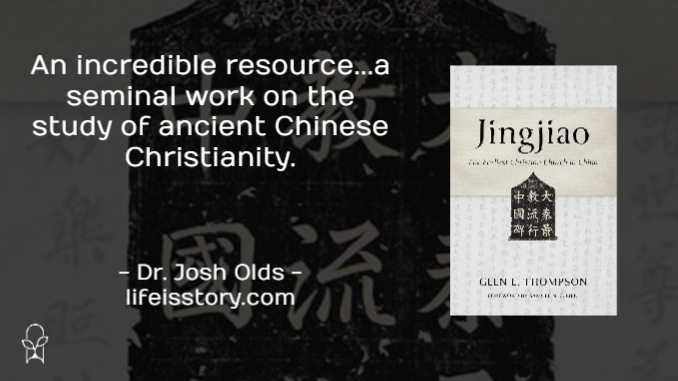
Published by Eerdmans on February 15, 2024
Genres: Academic, Non-Fiction
Buy on Amazon
Goodreads

A balanced, accessible, and thorough history of Jingjiao, the first Christian church in China
Many people assume that the first introduction of Christianity to the Chinese was part of nineteenth-century Western imperialism. In fact, Syriac-speaking Christians brought the gospel along the Silk Road into China in the seventh century. Glen L. Thompson introduces readers to the fascinating history of this early Eastern church, referred to as Jingjiao, or the “Luminous Teaching.”
Thompson presents the history of the Persian church’s mission to China with rigor and clarity. While Christianity remained a minority and “foreign” religion in the Middle Kingdom, it nonetheless attracted adherents among indigenous Chinese and received imperial approval during the Tang Dynasty. Though it was later suppressed alongside Buddhism, it resurfaced in China and Mongolia in the twelfth century. Thompson also discusses how the modern unearthing of Chinese Christian texts has stirred controversy over the meaning of Jingjiao to recent missionary efforts in China.
In an accessible style, Thompson guides readers through primary sources as well as up-to-date scholarship. As the most recent and balanced survey on the topic available in English, Jingjiao will be an indispensable resource for students of global Christianity and missiology.
In 2012, fresh out of seminary, I—a white man speaking zero Mandarin—took the position of youth pastor at a Chinese Church. At the time, I knew nothing about Chinese culture, little about Asian-American Christianity (did being a fan of Francis Chan count?), but had a lot of enthusiasm. Something I discovered in my time at the church was that—and this was never overtly stated—the church wanted their religion to be white. That is to say, even within a church dedicated to being a culturally safe place for Chinese-Americans, their religious perspective was that Christianity looked very much like white Christianity. I don’t mean this as a condemnation, but just an observation. The Christianity they had been taught was from the perspective of majority white culture and with that came a struggle with how or if to incorporate their Chinese heritage.
Jingjiao (景教) is a book about ancient Chinese Christianity. The title comes from the name for the church during the Tang dynasty (7th-10th century) and literally means “luminous religion.” Because of the cultural dominance of the West, while the spread of Christianity westward is more well-known, its movement through the East is not as well chronicled or known. Jingjiao is the story of this forgotten history, a story that makes it clear that Christianity fits into all cultures and not just Eurocentric ones.
Glen Thompson’s comprehensive work is so clearly a passion project that even if you have no interest in the material, I think you’ll find the tone infectious. He writes a compelling narrative, deftly walking the balance between information overload and assuming readers know the context. While this is an academic work, you don’t have to be a theologian or a historian to read it. In fact, I think the best audience for this book are Chinese Christians looking to relate historically and culturally to their faith.
Jingjiao tells a story about a Christianity developing separate from colonialist and imperialist powers, integrating itself into Eastern culture, and growing and thriving for hundreds of years. Thompson goes pretty much chronologically, beginning with the Syriac church and how its movement eastward predicated the beginnings of the church in China. Using archaeological sources, Thompson is able to show that Christianity, the Jingjiao, began to flourish in China in the late 600s. One source from the time reads: “the pure, bright Luminous Teachign was introduced to our Tang kingdom. Its scriptures were translated and temples built; the [spiritually] dead revived and boats gave passage [to heaven.]”
Using that source material, Jingjiao is then able to give readers a broad outline of ancient Chinese Christian teaching. It is interesting to see how the mode of the Gospel (not the message but the manner in which it is given) is fully clothed in Chinese cultural imagery, terminology, and understanding—yet it is fully orthodox in its teachings. Again, Thompson is scholarly and comprehensive, but also accessible. This is not an academic review of archaeological findings, but the retelling of a lost history that has value for Christians today.
Overall, this is an incredible resource for students of the history of religion for the gaps it fills in the literature on ancient Chinese Christianity. Thompson gathers and makes accessible a number of obscure and difficult to obtain documents and, from a scholarly perspective, really advances the field. It’s paradigm-shifting missiologists working in the East because it gives them knowledge of an ancient, indigenous Christianity that has culturally Chinese distinctives. But most importantly, I think, is the value Jingjiao has for Chinese-American churches struggle to balance their cultural distinctiveness with “American” religion.
